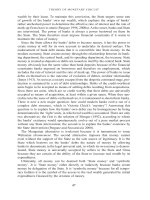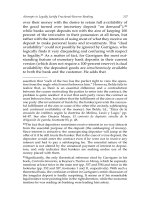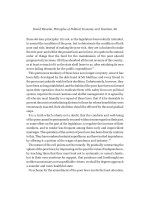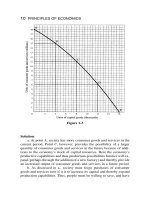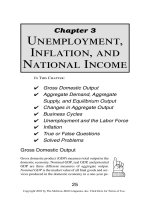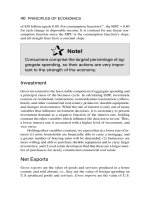your credit score your money and whats at stake phần 3 potx
Bạn đang xem bản rút gọn của tài liệu. Xem và tải ngay bản đầy đủ của tài liệu tại đây (2.09 MB, 22 trang )
ptg
However, the scores are also designed to react strongly to any signs that
a once-good risk might be turning bad. That’s why someone with a good
score might suffer more heavily from a late payment.
It’s generally a lot easier to lose points on your score than it is to gain
them back, which is why it’s so important to know how to improve and pro-
tect your score.
The Five Most Important Factors
Now that you understand in general how credit scores are calculated, we can
move on to some specifics. The following are the five main factors that affect
your FICO score according to their relative level of importance, along with a
percentage figure that reflects how heavily that factor is weighed in calculat-
ing FICO scores for the general population. Each factor might weigh more or
less heavily in your individual score, depending on your credit situation.
Your Payment History
This makes up about 35 percent of the typical score. It makes sense: Your
record of paying bills says a lot about how responsible you are with credit.
Lenders want to know whether you pay on time and how long it’s been since
you’ve been late, if ever.
To put this in perspective: More than half of Americans don’t have a sin-
gle late payment on their credit reports, according to Fair Isaac, and only 3 in
10 have ever been 60 days or more overdue in the past 7 years.
When it comes to negative marks like late payments, the score focuses
on three factors:
• Recency—This is how recently the borrower got into trouble.
The more time that’s passed since the credit problem, the less
it affects a score.
• Frequency—As you might expect, someone who has had just
one or two late payments typically looks better to lenders than
someone who has had a dozen.
• Severity—There’s a definite “hierarchy of badness” when it
comes to your credit score. A payment that’s 30 days late isn’t
CHAPTER 2HOW CREDIT SCORING WORKS 21
From the Library of Melissa Wong
ptg
considered as serious as one that’s 60 or 120 days late.
Collections, tax liens, and bankruptcy are among the biggest
black marks.
If you’ve never been late, your clean history will help your score. But
that doesn’t mean you’ll get a “perfect” score. A good credit history involves
a lot more.
How Much You Owe
This equates to 30 percent of your score. The score looks at the total amount
owed on all accounts, as well as how much you owe on different types of
accounts (credit card, auto loan, mortgages, and so on).
To put this in perspective: Most Americans use less than 30 percent of
their available credit limits, according to Fair Isaac. Only 1 in 7 uses 80 per-
cent or more of available limits.
As you might expect, using a much higher percentage of your limits will
worry lenders and potentially hurt your score. People who max out their
credit limits, or even come close, tend to have a much higher rate of default
than people who keep their credit use under control.
When it comes to revolving debt—credit cards and lines of credit—the
credit score formula looks at the difference between your credit limits on
the accounts and your balance, or the amount of credit you’re actually using.
The bigger the gap between your balance and your limit, the better.
Here’s a point that needs clarification: Lenders report your balances to
the credit bureaus on a given day (usually each month, but sometimes only
every other month or quarterly). It doesn’t matter whether you pay the bal-
ance off in full the next day—the balance you owed on the reporting day is
what shows up on your credit report. That’s why people who pay off their
credit cards in full every month still might have balances showing on their
reports.
So you need to be careful with how much you charge, even if you never
carry a balance from month to month. Your total balance during the month
should never approach your credit limit if you want a good score.
The score also looks at how much you owe on installment loans (mort-
gages, auto loans) compared to what you originally borrowed. Paying down
the balances over time tends to help your score.
22 YOUR CREDIT SCORE
From the Library of Melissa Wong
ptg
How Long You’ve Had Credit
This is 15 percent of your total score. As such, it’s generally much less
important than the previous two factors, but it still matters. You can have a
good score with a short history, but typically the longer you’ve had credit, the
better.
To put this in perspective: The average American’s oldest account has
been established for about 14 years, according to Fair Isaac. One in four has
an account that’s been established for 20 years or more.
The score considers both of the following:
• The age of your oldest account
• The average age of all your accounts
Your Last Application for Credit
This is 10 percent of your overall score. Opening new accounts can ding your
credit score, particularly if you apply for lots of credit in a short time and you
don’t have a long credit history.
To put this in perspective: The average American has not opened an
account in 20 months.
The score factors in the following:
• How many accounts you’ve applied for recently
• How many new accounts you’ve opened
• How much time has passed since you applied for credit
• How much time has passed since you opened an account
You might have heard that “shopping around” for credit can hurt your
score. We deal with this issue more thoroughly in Chapter 4, “Improving
Your Score—The Right Way,” but the FICO formula takes into account that
people tend to shop around for important loans such as mortgages and auto
financing. As long as you do your shopping in a fairly concentrated period of
time, it shouldn’t affect the score used for your application.
CHAPTER 2HOW CREDIT SCORING WORKS 23
From the Library of Melissa Wong
ptg
Also, pulling your own credit report and score doesn’t affect your score.
So long as you do it yourself, ordering from a credit bureau or a reputable
intermediary, the inquiry won’t count against you. If you have a lender pull
your score “just to see it,” though, you could end up hurting your score.
The Types of Credit You Use
This is 10 percent of your score. The FICO scoring formula wants to see a
“healthy mix” of credit, but Fair Isaac is customarily vague about what that
means.
The company does say that you don’t need to have a loan of each possi-
ble type—credit card, mortgage, auto loan, and so on—to have a good score.
Furthermore, you’re cautioned against applying for credit you don’t need in
an effort to boost your score, because that can backfire.
To get the highest possible scores, however, you need to have both
revolving debts like credit cards and installment debts like an auto loan,
mortgage, or personal loan. These latter loans don’t have to still be open to
influence your score. But they do still need to show up on your credit report.
Bankcards—major credit cards such as Visa, MasterCard, American
Express, Discover, and Diner’s Club—are typically better for your credit
score than department store or other “finance company” cards. (Department
stores’ cards are typically issued by finance companies, which specialize in
consumer lending and which, unlike banks, don’t receive deposits.)
Installment loans can reflect well on you, too. That’s because lenders
generally require more documentation and take a closer look at your credit
before granting the loan.
To put this in perspective: The average American has 13 credit accounts
showing on their credit report, including 9 credit cards and 4 installment
loans, according to Fair Isaac.
Your Credit Scorecard
How these five factors are weighed when it comes to you—as opposed to the
general population—depends on a little-known sorting system known at Fair
Isaac as “scorecards.”
Scorecards allow the FICO formula to segment borrowers into one of ten
different groups, based on information in their credit reports.
24 YOUR CREDIT SCORE
From the Library of Melissa Wong
ptg
If the credit history shows only positive information, the model takes into
account the following:
• The number of accounts
• The age of the accounts
• The age of the youngest account
If the history shows a serious delinquency, the model looks for these:
• The presence of any public record, such as a bankruptcy or tax lien
• The worst delinquency, if there’s more than one on the file
After the model has this information, it decides which of the ten score-
cards to assign. Although Fair Isaac keeps the details pretty secret, it’s known
that there is at least one scorecard for people with a bankruptcy in their back-
grounds, and another for people who don’t have much information in their
reports.
Grouping people this way is supposed to enhance the formula’s predic-
tive power. The theory is that the same behavior in different borrowers can
mean different things. Someone with a troubled credit history who suddenly
opens a slew of accounts, for example, might be seen as a much greater risk
that someone with a long, clean history. Scorecards allow the FICO formula
to give different weight to the same information.
Sometimes, however, the actual results of the scorecards can be a little
bizarre.
Naomi of Richmond, Virginia, spent years rebuilding her credit and
couldn’t wait for the seven-year mark to pass on three negative items on her
credit report: two collection actions and a judgment. These items, she was
sure, were the only things holding her credit score down.
When the black marks disappeared from her report, however, Naomi’s
score actually dropped more than 20 points. Naomi got caught in what can
be a jarring transition from one scorecard to the next.
The negative items on her credit report got her assigned to a certain
scorecard, but her efforts to rebuild her credit—making payments on time
and using credit responsibility—helped her rise to the top of that scorecard
group.
CHAPTER 2HOW CREDIT SCORING WORKS 25
From the Library of Melissa Wong
ptg
When her negative marks disappeared, though, she was transferred to
another group with tougher standards. In that group, she was closer to the
bottom, and her credit score drop reflected her fall.
Naomi’s only solace is that the responsible credit behavior she’s learned
should help boost her score and recover lost ground over time.
Your Results Might Differ
You need to know about a few more complications.
Although all three bureaus use the FICO scoring model, the actual for-
mula differs slightly from bureau to bureau. That’s because the way the
bureaus collect and report data isn’t exactly the same. It’s unlikely that these
differences would have much impact on your score, but you should know that
they exist. You’re much more likely, though, to have different scores from
bureau to bureau because the underlying information is different.
As discussed earlier, lenders can have their own in-house scoring formulas
in addition to, or instead of, using FICO scores. Lenders also can use different
“editions” of the FICO formula. Just as not everyone updates to the latest com-
puter operating systems when they’re released, not every lender uses the latest
versions of credit-scoring formulas.
Older versions of the FICO formula, for example, counted participation
in a credit-counseling program as a negative factor; newer versions view it as
a neutral factor. So, if you’re currently in a debt management program, you
might be viewed more negatively by some lenders than by others.
Just consider what happened to Marvin, a home buyer who learned too
late that his scores weren’t what he thought they were.
Marvin purchased FICO scores from each of the three credit bureaus.
Because lenders usually use the middle of your three scores to determine
your interest rates, Marvin was happy to discover his middle score was 638—
not great, but high enough to avoid the 620 mark many lenders use to classi-
fy a borrower as subprime, or high risk.
When Marvin applied for a loan, however, the lender told him his mid-
dle score was 593. It’s not clear whether the lender was using an older FICO
formula or was simply using its own modified concoction and calling it a
FICO, but Marvin paid the price:
26 YOUR CREDIT SCORE
From the Library of Melissa Wong
ptg
“No one tells you this when you pay your money to get your score,”
Marvin said. “We actually put our house on the market based on the
information we received from the agencies, having to scramble later for a
mortgage company to accept our lower score. We went from being able to
receive competitive interest rates to being considered very high risk and
receiving very high rates.”
You can help protect yourself somewhat from these discrepancies by
being preapproved for a home loan before you start house shopping. But this
is just another reason why it’s important to improve and protect your score.
The higher your score is, the less you have to worry about a few points mak-
ing a difference.
How Do I Get My Score?
If you’ve surfed the Internet lately, you might find it hard to believe that cred-
it scores were secret only a few short years ago. Sometimes it seems like
every other Web site is either hawking credit scores or running an ad for a
Web site that does.
As you’ve read, though, not all credit scores are created equal.
The credit bureaus, for example, sometimes market scores to consumers
that aren’t based on the FICO formula—the one typically used by lenders.
The bureaus say these scores are a good indicator of a consumer’s credit-
worthiness, but their results can differ—sometimes markedly—from the
FICO numbers that lenders use.
Your first step: Make sure you’re getting a real FICO score. If it doesn’t
say FICO or use one of the credit bureau’s trademarked names for FICO
scores, it’s not the same formula lenders use.
The FICO score has different names at the three major credit bureaus.
Credit Bureau FICO Score Name
Equifax, Equifax Canada Beacon
Experian Experian/Fair Isaac Risk Model
TransUnion, TransUnion Canada Empirica or FICO Risk Score, Classic
Be careful not to be misled by pitches that promise “free” access to your
credit score. Typically, those offers require signing up for credit monitoring
or other ongoing services that are most assuredly not free. Although you
might decide that these services are helpful, make sure to read the fine print
CHAPTER 2HOW CREDIT SCORING WORKS 27
From the Library of Melissa Wong
ptg
so that you understand what you’re getting and how you can cancel if neces-
sary. Another caution: Some fly-by-night operators might pitch credit scores
as a way to get you to reveal your private financial information, such as your
Social Security number or credit card numbers. As always on the Web, it’s
best to do business with companies you know and to make sure you have a
secure connection before transmitting sensitive information. Congress in
2003 gave U.S. residents the right to get free copies of their credit reports
annually from each of the three bureaus. But that doesn’t include the right to
free scores; the bureaus can and will continue to charge for those.
One place to look for your score is MyFICO.com, a joint venture
between Fair Isaac and Equifax. The site offers your credit reports and FICO
scores from each of the three bureaus for about $47.85. (One score and one
report is $15.95.)
In Canada, you can get your FICO score from Equifax Canada.
Along with your score, MyFico.com provides a “fever” chart that shows
where you stand in relation to other borrowers, along with a summary of how
lenders are likely to view you as a credit risk.
In Figure 2.1, the borrower has an Experian FICO score of 776, which
puts her ahead of about 75 percent of other Americans.
Figure 2.1 How you rank
28 YOUR CREDIT SCORE
0% 10% 20% 30% 40% 50% 60% 70% 80% 90% 100%
550 600 650 700 750 800
FICO Score Range
Highest risk Lowest risk
Percentage of U.S. consumers with a lower score than yours
776
Source: Fair Isaac Co. Used by permission.
MyFico.com goes on to tell you more what this means, saying in part:
Lenders consider many factors in addition to your credit score when
making credit decisions. Looking solely at your FICO score, however,
most lenders would consider this score as excellent.
This means: It is extremely unlikely your application for credit cards or
for a mortgage or auto loan would be turned down, based on your score
alone.
From the Library of Melissa Wong
ptg
You should be able to obtain relatively high credit limits on your credit
card.
Most lenders will consider offering you their most attractive and most
competitive rates.
Many lenders will also offer you special incentives and rewards targeted
to their “best” customers.
Source: MyFico.com
Because the primary purpose of a FICO score is to predict default risk,
you might be interested to know how you stack up in that regard. As you can
see from the following chart, compiled by MyFico.com for a borrower with
a FICO score of 700, the risk of fault rises dramatically as scores drop:
Figure 2.2 Your risk of default
CHAPTER 2HOW CREDIT SCORING WORKS 29
100%
80%
60%
40%
20%
0%
80%
70%
51%
31%
14%
5%
2%
1%
Rate of credit delinquencies
Delinquency Rates by FICO Score
300-499
500-549 550-599
600-649
650-699
700-749
750-799
800+
FICO score range
Source: Fair Isaac Co. Used by permission.
When you get your FICO, you should get a summary of the major fac-
tors influencing your score. Be sure to read these carefully, along with any
additional explanatory information. These factors are provided to give you
some clues about how to improve your score, but if you misinterpret the
results, you could end up making things worse.
For example, many people with good credit often find that one of the rea-
sons their score isn’t higher is that they have “too many credit cards.” They
think they can solve the problem by closing cards, but the FICO formula
doesn’t work that way. The closed cards remain on your credit report and
continue to influence your score. In fact, the act of closing accounts can actu-
ally hurt your score, as I explain later, and can never help it.
From the Library of Melissa Wong
ptg
The positive factors you’ll see should be listed in order of importance,
and might be something like the following:
• You have no late payments reported on your credit accounts.
• You demonstrate a relatively long credit history.
• You have a low proportion of balances to credit limits on your
revolving/charge accounts.
Negative factors, too, should be listed in order of importance. If you have
a bankruptcy, collections action, or other serious delinquency, that would be
mentioned first. Other negatives that can show up for even the best borrow-
ers include the following:
• You have recently been seeking credit or other services, as
reflected by the number of inquiries posted on your credit file
in the past 12 months.
• You have a relatively high number of consumer finance com-
pany accounts being reported.
• The proportion of balances to credit limits (high credit) on
your revolving/charge accounts is too high.
• The length of time your accounts have been established is rela-
tively short.
Now, nobody likes criticism, and some people get absolutely furious
when they read through the reasons they’re given for why their score isn’t
higher. Interestingly, many of these folks tend to have excellent credit, but—
like Brian in the previous chapter—they’re angry that their score isn’t “per-
fect.”
Understand that nobody is “perfect,” and even if you could achieve a per-
fect FICO score, the changing circumstances of your life and your credit use
would mean you wouldn’t keep that score for long.
Also understand that the negative reasons listed are less and less impor-
tant the higher your score. The bureaus need to give you some reason for why
your scores aren’t higher, but when your score is already in the mid-700s and
above, there’s no guarantee that even if you could fix the “problem” that your
scores would rise that much.
30 YOUR CREDIT SCORE
From the Library of Melissa Wong
ptg
Still, you can always learn something from reading the reasons given. A
notation that your balances are too high should spur you to pay down your
debt, for your own financial health as well as for the sake of your score.
Getting dinged for having too many cards should keep you from applying for
yet another department store card just to get a 10 percent discount. You don’t
need one more piece of plastic to keep track of, anyway.
If your score is low, however, you should take the negative factors to
heart. They can provide a blueprint for fixing your credit and boosting your
score. In Chapter 4, you’ll find general information about improving your
score, and in later chapters, I discuss more specific strategies for people who
have troubled credit.
FICO 08: Changes in Store
Early in 2008, Fair Isaac announced it would be rolling out a new iteration of
the FICO called FICO 08.
The new score, Fair Isaac promised, would do a better job of predicting
defaults, particularly among customers with poor, thin, or young credit his-
tories. Compared to the classic FICO, FICO 08
• Is less punishing to those who have had a serious credit set-
back, such as a charge-off or a repossession, as long as their
other active credit accounts are all in good standing.
• Entirely ignores small collections where the original debt was
less than $100. (This is a huge victory for consumers, many of
whose credit reports have been tarnished by small-ticket dis-
putes and minor medical bills their insurance companies failed
to pay.)
• Is even more sensitive to the balances reported on consumers’
credit cards.
• Responds more positively if borrowers have both revolving and
installment accounts.
• Responds more negatively if consumers have few open, active
accounts.
• Protects against so-called authorized user abuse.
CHAPTER 2HOW CREDIT SCORING WORKS 31
From the Library of Melissa Wong
ptg
As I discuss in Chapter 4, adding a spouse or child to your credit card as
an authorized user has long been a good way to boost that person’s credit
score, because your good history with the account could be imported to their
credit file. But in 2007, credit repair firms began abusing this feature by
“renting” authorized user slots from good credit risks and selling them to
complete strangers who wanted to boost their scores. Some of these strangers
bought slots on dozens of different people’s cards, boosting their scores by
tens or even hundreds of points.
Fair Isaac originally said FICO 08 would combat possible fraud by
ignoring all authorized user information, drawing protests from consumer
advocates who pointed out that the change would punish the innocent as well
as the guilty. Furthermore, experts theorized that ignoring information
regarding spouses on authorized credit lines could be a violation of the Equal
Credit Opportunity Act.
So Fair Isaac rejiggered the FICO 08 formula to include authorized user
accounts “while materially reducing potential impacts to the score,” accord-
ing to the company’s FICO 08 marketing brochure. Exactly how it does that
is as secret as the rest of the formula, but speculation is that the new score
will count a limited number of authorized user accounts and ignore the rest.
Another change Fair Isaac made after unveiling the new score was in
how it counted inquiries. The original FICO 08 formula dinged credit seek-
ers less than the classic FICO score for opening new accounts, based on
research that inquiries had become less predictive of defaults over time.
Interestingly, the relationship between inquiries and defaults reestablished
itself in subsequent months, so the current FICO 08 formula treats them
much the same way the classic FICO does.
Because of this and other delays, FICO 08 fell behind schedule. Fair
Isaac now expects the credit bureaus to begin offering the score to lenders
starting in early 2009.
There’s no telling whether, or how quickly, FICO 08 will supplant the
classic FICO score. Fair Isaac’s previous major attempt to improve on the
FICO, a scoring formula called NextGen, fell flat—in part because NextGen
relied on a 150-to-950 scale that would have required lenders to revamp their
underwriting systems and software—major modifications in which few com-
panies wanted to invest.
FICO 08, however, retains classic FICO’s 300-to-850 scale and its “rea-
son codes”—specific explanations of why the score is what it is. That means
lenders have to go to much less effort to switch, which may improve its
chances of adoption.
32 YOUR CREDIT SCORE
From the Library of Melissa Wong
ptg
Fortunately, all the strategies I outline in Chapter 4 for improving your
score work with both iterations of the FICO score. To better understand the
nuances of the change, however, read the following scenarios Fair Isaac cre-
ated to demonstrate how FICO 08 works.
FICO 08 Score: Three Consumer Scenarios
Scenario 1: Higher-risk consumers
Consider two people named Jose and Alicia who have
similar credit histories:
• Each has about ten accounts (open or closed) on their
credit report.
• Each has been managing credit for about ten years
based on the age of their oldest reported accounts.
• Each has at least one major account delinquency on
their credit report (such as a charge-off or reposses-
sion).
• Neither has a public record on their credit report
(such as a tax lien or bankruptcy).
• Each has a current FICO credit score of about 625.
When a lender checks their FICO 08 scores, however,
Alicia receives a score of about 650, whereas Jose
receives a score of about 600. Here’s what led to this dif-
ference in outcomes.
Alicia receives a FICO 08 score of 650:
• Compared to Jose, Alicia’s credit report shows a rel-
atively higher number of open accounts that are
reported as paid-as-agreed. So she received more
points for having credit accounts in good standing.
• Her credit report demonstrates she has had a mixture
of revolving (credit cards) and installment (auto loan,
student loan, and so on) accounts. So she received
more points for demonstrating a good ability to han-
dle a variety of credit types.
CHAPTER 2HOW CREDIT SCORING WORKS 33
From the Library of Melissa Wong
ptg
Jose receives a FICO 08 score of 600:
• Compared to Alicia, Jose’s credit report shows more
closed accounts and fewer open accounts that are
reported as paid-as-agreed. So his score is lower in
response to his report showing that he has compara-
tively less recent experience in managing credit
responsibly.
• His credit report also has no open or active install-
ment loan account on file. So his score is lower due to
a lack of demonstration that he has successfully man-
aged a variety of credit types.
Scenario 2: Thin-file consumers
Now consider two consumers named Bill and Jennifer
who have similar credit histories:
• They each established their first credit account less
than three years ago.
• They each now have five accounts listed on their cred-
it report.
• Neither credit report shows a serious credit delin-
quency (90 days or more past due).
• Each has a current FICO credit score of about 665.
When a lender checks their FICO 08 scores, Bill receives
a score of about 685, whereas Jennifer receives a score
of about 645. Here’s what led to this difference in out-
comes.
Bill receives a FICO 08 score of 685:
• His credit report shows that he has a relatively larger
number of open accounts that have been paid-as-
agreed.
• None of his reported accounts has a high balance rel-
ative to the credit limit.
34 YOUR CREDIT SCORE
From the Library of Melissa Wong
ptg
Jennifer receives a FICO 08 score of 645:
• Her credit report shows that she has relatively few
active, open accounts compared to Bill. This means
there is less evidence in her file that she is handling
her credit well.
• She has at least one revolving account with a high
balance relative to the credit limit. This is significant in
her case because higher credit utilization can have
greater weight as a risk factor in the calculation of
FICO 08 scores.
Scenario 3: Mainstream consumers
Now consider two more consumers named Isabel and
Fred who have similar credit histories:
• The oldest account on their respective credit reports is
about ten years old.
• Their credit reports each contain between 15 and 20
accounts.
• Neither credit report shows a serious credit delin-
quency (90 days or more past due).
• Each has a current FICO credit score of about 725.
When a lender checks their FICO 08 scores, Isabel
receives a score of about 745, whereas Fred receives a
score of about 705. Here’s what led to this difference in
outcomes.
Isabel receives a FICO 08 score of 745:
• Compared to Fred, Isabel has lower balances and is
using comparatively less of her available credit. She
also has more credit card accounts on her credit
report that show a balance. Combined, these two fac-
tors demonstrate that she is actively using her credit
and is handling it responsibly.
• Her credit report also contains an open auto loan
account that has mostly been paid off. So she
received more points for demonstrating a good abili-
ty to handle a variety of credit types.
CHAPTER 2HOW CREDIT SCORING WORKS 35
From the Library of Melissa Wong
ptg
Fred receives a FICO 08 score of 705:
• Compared to Isabel, Fred’s report shows more credit
card accounts with higher balances. Because having
high utilization correlates to statistically greater cred-
it risk, it lowers his score.
• While he has an open auto loan on his credit
report, very little has been paid down from the
original loan amount. So although Fred’s score
benefits from the variety of credit types on his
report, he hasn’t yet demonstrated the ability to
handle installment loans over time, and this is
reflected in his receiving fewer points in this area
than Isabel.
36 YOUR CREDIT SCORE
From the Library of Melissa Wong
ptg
3
VantageScore—
A Revolution or Just
More of the Same?
37
The three major credit bureaus—Experian, Equifax, and TransUnion—made
a big splash in March 2006 when they announced a new credit-scoring sys-
tem called VantageScore. In an unprecedented move, the three competing
bureaus worked together to create a scoring system to rival the entrenched
FICO.
Using words such as innovative, consistent, and accurate, the bureaus
strongly implied that they had created a better mousetrap.
Many media outlets picked up the hype, proclaiming that VantageScores
were an improvement on the FICO scores that most lenders use. Articles and
broadcasts proclaimed the new credit score was “great news for consumers,”
that it would “simplify” or “remake” the credit application process. One
columnist even proclaimed, with little apparent evidence, that “creditworthy
people…are more likely to get credit now.”
From the Library of Melissa Wong
ptg
People who know about credit scoring took a decidedly more “wait and
see” attitude. So far, VantageScore has not managed to push FICO off its
perch as the leading credit score.
We discuss the reasons for this later in the chapter. For right now, let’s
discuss the nuts and bolts of VantageScore.
The VantageScore Scale
Whereas the classic FICO score ranges from 300 to 850, the VantageScore
runs from 501 to 990. To make the score more “intuitive,” the bureaus
designed each tier to correspond to the alphabetic grading system that most
of us know from elementary school:
901–990 equals A credit
801–900 equals B credit
701–800 equals C credit
601–700 equals D credit
501–600 equals F credit
At the time the bureaus announced the VantageScore, they released sta-
tistics showing the percentage of population with each “grade.” Put those sta-
tistics next to similar statistics supplied by Fair Isaac for FICO scores, and
you’ll soon notice something interesting.
VantageScore % with Score FICO Score % with Score
900–990 A 11% 800–850 13%
801–900 B 29% 750–799 27%
701–800 C 21% 700–749 18%
601–700 D 20% 650–699 15%
501–600 F 19% 600–649 12%
550–599 8%
500–549 5%
300–499 2%
The two scoring systems manage to put similar percentages of people in
their highest three tiers. The FICO scale offers more tiers at the lower end
38 YOUR CREDIT SCORE
From the Library of Melissa Wong
ptg
than VantageScore, but the percentage of folks in the basement appears
roughly the same.
Under the VantageScore system, 19 percent of borrowers have F credit.
If you use a FICO score of 620 as a cutoff point for subprime credit, which
many lenders do, you get similar results: Fair Isaac says that 19 percent of
consumers have FICO scores below 620.
The bureaus and Fair Isaac caution against drawing conclusions from
this comparison about where any consumer might stand in one system versus
the other. But it does appear possible that some people who would rate a good
score from Fair Isaac—say, in the low 700s—might wind up getting a C rat-
ing from VantageScore.
The only way to know where you stand, of course, is to get your
VantageScore. As of this writing, Experian was offering its version of the
VantageScore for $5.95 on its Web site. The other two bureaus had plans to
follow suit.
How VantageScores Are Calculated
Like FICO scores, VantageScores are calculated using the information in your
credit reports. The factors considered are similar—your payment history, your
balances, your credit limits, how long you’ve had credit, how recently you’ve
applied for credit, and the mix of credit accounts in your file.
As you’ll see, though, VantageScore divides these factors somewhat dif-
ferently than FICO and doesn’t give all of them the same definitions or
weights.
The following factors influence a VantageScore:
• Payment history: 32 percent—Whether your payments are
satisfactory, delinquent, or derogatory
• Utilization: 23 percent —The percentage of credit that you
have used or that you owe on your accounts
• Balances: 15 percent—The amount of recently reported
balances, both current and delinquent
• Depth of credit: 13 percent—The length of your credit history
and the types of credit you have
CHAPTER 3VANTAGESCORE—A REVOLUTION OR JUST MORE OF THE SAME? 39
From the Library of Melissa Wong
ptg
• Recent credit: 10 percent—The number of recently opened
accounts and credit inquiries
• Available credit: 7 percent—The amount of available credit
on all your accounts
If you compare that breakdown to FICO, you’ll see that both systems
devote roughly one-third of the score (35 percent for FICO, 32 percent for
VantageScore) to payment history and 10 percent to how recently you last
applied for credit.
But here the systems diverge. FICO devotes a full quarter of its score to
the length of your credit history and your mix of credit, factors that make up
just 13 percent of the VantageScore.
Nearly half the VantageScore—45 percent—is made up of factors that
take into account how much credit you have and how much you’re using,
something that comprises 30 percent of your FICO score.
So it’s reasonable to expect that the same action—applying for a loan,
opening or closing a bank account, paying down a debt—might affect your
scores under the two systems in different ways.
Comparing the Scoring Systems
We already know that the same action can have dissimilar effects on people’s
FICO scores, depending on their particular credit situations and the informa-
tion in their files. Someone who has excellent credit, for example, typically
loses many more points by making a late payment than someone who already
has a lot of delinquencies on his reports.
But there’s some evidence that the same action can affect a person’s
VantageScore differently than his FICO.
For instance, Fair Isaac says it’s relatively rare for a new credit account
to boost a FICO or even leave it unchanged. Typically, new accounts reduce
a FICO by at least a few points, and sometime more.
Illustrations provided by Experian’s VantageScore site, however, show
applications for credit significantly increasing scores for some borrowers.
Experian created three fictional borrowers with different scores and then
showed the effects of applying for a credit card and a $20,000 loan.
40 YOUR CREDIT SCORE
From the Library of Melissa Wong
ptg
Credit Actions and Their Effect on VantageScores
John, 912 (A) Sally, 827 (B) Jimmy, 604 (D)
Opening a bankcard +13 points +4 points +2 points
with a $5,000 limit
Receiving a +23 points –20 points +5 points
$20,000 loan
John, the A credit borrower, benefits the most from opening new credit
and suffers the least from closing an account. The $20,000 loan that adds sig-
nificantly to his score would, by contrast, shave 20 points from Sally’s.
Jimmy, the D scorer, gets a boost from either type of loan, but the benefit is
just a few points.
At the time of this writing, Experian didn’t have a simulator that would
allow consumers to see how such actions would impact their individual
VantageScores, so I couldn’t tell how opening a credit card account or a car
loan would affect my own score.
I was, however, able to use MyFico’s credit score simulator to see what
impact the same actions would have on my FICO. I used my Experian FICO,
which at the time was 810, or in the top 2 percent of the U.S. population. (On
Experian’s VantageScore scale, I rated at the top of the A students, with a
score of 990; Experian says only about 1 percent of the population scores that
high.)
As you’ll see, my answers were somewhat different from those experi-
enced by John with the A rating from VantageScore.
(I need to add here that a major problem with MyFico’s score simulator
is that it isn’t specific. It gives you a range of possible impacts on your score,
and as you’ll see, the range often isn’t that helpful.)
When I asked what my score would be after opening a $5,000 bankcard,
for example, the MyFico.com simulator gave me a range of 800 to 820. In
other words, such an action could depress my FICO as much as 10 points—
or it could boost it by 10. That’s a pretty big difference. (If the new card did
increase my score by 10 points, that would be a 1.2 percent increase—simi-
lar to the 1.4 percent increase John experienced in the VantageScore illustra-
tion.)
My taking out a $20,000 auto loan would result in a score of 780 to 810,
according to the MyFico simulator. So I could lose up to 30 points, or my
score could be unaffected. Either way, it’s not the 2.2 percent improvement
John experienced in the VantageScore illustration.
CHAPTER 3VANTAGESCORE—A REVOLUTION OR JUST MORE OF THE SAME? 41
From the Library of Melissa Wong
ptg
Some Rules Remain the Same
The simulators do tell us enough to make some things clear, such as the fact
that late payments under either system injure everyone’s scores, and those
with the best scores have the most to lose.
Failing to pay a bankcard one month—in other words, a 30-day late—
would cost the D-scoring consumer, Jimmy, 13 points, or 2.2 percent of his
score.
The same 30-day late would whack 109 points from B-scorer Sally’s
numbers, a 13.2 percent drop. John would suffer a 176-point drop, losing
nearly 20 percent of his once-admirable score.
Likewise, paying down debt, particularly credit cards and other revolv-
ing accounts such as home equity lines of credit, tends to help everybody’s
score. But the better your score, the more you may have to pay to boost your
numbers.
To increase his score by 10 points, John would need to pay down his
$5,498 bankcard balance by $1,300. To achieve a similar 10-point improve-
ment, Sally would need to reduce her $450 retail card balance by just $190.
Closing a bankcard account, meanwhile, injured all three fictional char-
acters’ scores by different amounts.
As time passes, we may learn more about how VantageScore works and
how it compares with the FICO. For now, though, we know at least some of
the basic rules are the same between the systems. Here’s how to protect and
improve your score:
• Pay bills on time.
• Pay down your debt.
• Don’t close accounts.
VantageScore’s Future
When VantageScore was first announced, many credit experts predicted the
new system would have a tough time unseating the classic FICO score.
FICO scoring systems are deeply embedded in the complex, highly auto-
mated formulas that lenders use to evaluate current and potential borrowers.
Switching to a new scoring system can be quite expensive and difficult.
42 YOUR CREDIT SCORE
From the Library of Melissa Wong


